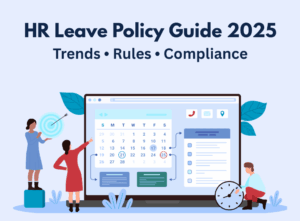Today’s corporate culture is radically different from what was prevalent even a decade ago. There is so much more emphasis on making the work culture employee-centric instead of being employer-centric like before. Many studies and researches have been done to prove that having happy employees is the key to a company’s success. Slowly, the organizations have also woken up to these studies and have made numerous efforts to make the workplace better for all the employees. Companies like Google and Facebook have set the benchmark worldwide in being the places to work for in terms of the amenities and perks they offer to their employees. Closer home, we have Myntra and Google India that provides their employees with the best of the best facilities and leaves us all green with envy.
The key word for this generation of employees is ‘work-life balance’ and the company that can get this right is the one that has the edge over everyone else in the market. In the 80s and the 90s, being a workaholic who spends the maximum hours on the work might have gotten you a better increment from your manager but this is not the case anymore. The new crop of employees have a life outside of their work that needs their attention as much and they need the organizations to acknowledge this too. From working extraordinarily long hours that leave no scope for personal life to working weekends that take away the only solace offered, the employees are not ready to put up with these and want the reins of their life back in their hands. Work-life balance has become such a key factor in making career decisions that many prefer a smaller paycheck if there is a semblance of a balanced work-life scenario.
If you are from a small or medium-sized organization, you might think that this is not applicable for you as you do not have the financial capabilities to pull off a fully-functional gym or sleeping pods in the office. But it is not about that as the biggest way to introduce work-life balance is through work flexibility, something that can be easily implemented in any organization without any major investment. In spite of being the buzzword, work flexibility raises a lot of eyebrows in many organizations. This is especially true if the organization is conservative and has an old-school, traditional approach to work. But what exactly does work flexibility mean and how can it be incorporated in your organization without compromising on efficiency and productivity? Is it worth the efforts and the hassles in the long run?
Work Flexibility – What Does It Entail?
Work flexibility refers to the practice of giving the employees a choice when it comes to how long, when and from where they should be able to work. This approach gives the employees autonomy and ownership over their work and lets them complete their job responsibilities at their own pace. The freedom that comes with work flexibility gives the employees the power to align their professional responsibilities with their personal needs.
The practice of work flexibility is in sharp contrast to the traditional approach to work where there are defined hours of work for everyone. Many conservatives frown upon work flexibility as they cling to the notion that employees’ presentism in the workspace equals work productivity. They fear that giving employees the flexibility of coming to and going from the office at their own time will make them slack on their work and shirk their responsibilities. The management also fears they will lose control of their employees, and therefore the work quality will suffer. There is no substance to this myth as those who are well devoted to their responsibilities will fulfill them at any cost while those who dilly-dally in their work will do so in conservative work arrangements too.
Even though work flexibility is the buzz word these days across all workspaces, it should not be implemented in any organization just for the sake of gaining some brownie points. This cannot be extended to all the employees if it is not conducive to their work responsibilities and the kind of work that they are engaged in. A computer engineer can code sitting at the comfort of her home or a café but a civil engineer cannot manage the construction site remotely. Work flexibility should only be implemented if it is mutually beneficial for both the employees and the organization otherwise it would only lead to chaos and failure. There are many organizations that require the compulsory physical presence of the employees and a flexible work arrangement would be detrimental to that effect.
How Work Flexibility Matters?
Work flexibility is in growing demand and why it would not be? No one would say no to a workplace that lets you come and go as you please, and lets you be the master of your work timings. Although it may seem that it is only beneficial for the employees, the benefits it brings to an organization are immense and worth the switch. Work flexibility is no more a perk but a strategic imperative move that can turn around a company’s future.
One of the topmost challenge that the organizations around the world face, year in and year out, is employee retention. Unless employees feel content and satisfied at their current work place, they would be looking for greener pastures elsewhere. With work-life balance, a top career priority for the young generation of workers, implementing working flexibility would mean that the current crop of employees will have more control of their time and therefore, a more balanced life. Many are even ready to take up lower paychecks in exchange for flexible work timings. All of this translates to lower attrition rates and increased employees’ loyalty, a big win-win for any organization.
With work flexibility, employees have a sense of peace as they do not have to worry about rigid work schedules. They can take time off from work without feeling guilty as they can adjust their working hours according to their needs. When the employees are relaxed and happy, it shows up in their work performance. Right from productivity to efficiency, work flexibility leads to a boost in everything. With less stress and boosted morale, even the creativity levels of the employees spike up. A happier workforce leads to great collaborations, improved teamwork and overall job satisfaction for everyone.
Since work flexibility is a big crowd-puller, it also builds up the reputation of any organization. Flexible working arrangements show that the organization values and cares for its employees and it can attract the best of the best talents in its sector. No one wants to work in an organization if the working hours are long and grueling, even if they love their job. Not just in terms of attracting the right talent to the organization, the work flexibility will help you retain your best employees and will save you lots in terms of financial costs incurred in hiring new talents to replace the ones who left.
Work flexibility does not mean just flexible working hours but also the option of remote working. Once the organization opens up to the idea of remote working, it increases its pool of prospective employees considerably and lets it choose the best talent available for its open job positions, regardless of the location where they are based. This also drastically lowers the absenteeism rate as the employees can always plan their vacation without missing their work.
When it comes to finances, work flexibility leads to lots of cost saving. If the employees have the option of remote working, the overhead administration costs are reduced while the improved productivity, efficiency, and teamwork lead to increased profits. No, this is not mere hearsay but studies have proven this that the organizations with work flexibility reap greater profits and meet more of their targets than their counterparts who do not subscribe to this practice.
How To Implement Work Flexibility Without Compromising On Productivity
Work flexibility in theory sounds really great but how to put it into practice? Does everyone gets a free pass to come and go as they please? Or now everyone can work from their home office or a pretty café downtown? In reality, work flexibility differs for everyone depending upon their job responsibilities and their personal needs. This well-intentioned move can spiral everything into chaos if it is not implemented properly and every employee is not given the necessary training to deal with this change. Here are some ways to make the most of work flexibility without compromising on work quality and productivity:
Choose The Work Flexibility That Suits You
Work flexibility is not just coming and going as you please. It incorporates a lot of different arrangements that can be adapted for any organization based on its needs and requirements. Choosing the best flexible work management is half- the battle won.
- FlexTime: The most obvious type of work flexibility, it entails giving the employees autonomy to decide their work days based on their personal and professional needs. Right from when and where they want to work and for how long, it is solely based on the employees’ discretion and relives the employees from the stress of balancing the personal life with the professional one. However, most of the organizations that follow FlexTime have some core working hours that they expect their employees to work compulsorily. If you incorporate a great Attendance Management system which has features to track remote working through IP based attendance, you can develop a great culture which fosters productivity while encouraging flexibility.
- Telecommuting: Telecommuting is another name given to remote working or the practice of employees working remotely from a non-company site. This can be anything from a home office to a co-working space or a café. Many organizations extend the option of ‘Work from Home’ to their employees for a few days in a week or even the whole week. This option is suitable for those who live far away from their offices and would need to commute a substantial amount of hours every day to reach the office. For those who are physically not able to commute or have someone dependent on them at home, this working arrangement comes across as a boon.
- Compressed Workweek: Compressed workweek involves the practice of working the same number of hours in a week but in fewer days. Most of the organizations have five working days with eight hours of work each day. Under the compressed work week arrangement, the employees can choose to work ten hours a day for four days a week to get an extra day off. This one extra day can do lots in terms of improving the work-life balance of the employees and easing up their burden.
- Job-sharing: Job-sharing is one of the less common flexible work arrangements followed in the industry. It involves the sharing of one full-time position by two part-time employees. This reduces the work burden by half and yet comes with the regular perks of the organization. This is best suited for those employees who would prefer to work part-time even if they possess the necessary qualifications for the full-time position. This involves a lot of collaboration and teamwork as the two employees need to coordinate accordingly to fulfill job responsibilities.
- Permanent Part-time Arrangements: This works perfectly well for those positions that do not need a full-time employee. The employee fills this part-time role that requires 20-29 hours of the work week. It gives the added benefits of deciding which days of the week the employee wants to work and for how long. The employee gets to avail the company benefits while the company does not need to hire someone full-time.
Customize To Meet Your Needs
Before taking a call on work flexibility implementation, talk to the team and take them into confidence.
When deciding on work flexibility agreements, it’s critical to consider the demands of your team members. To ensure the success of the flexible work arrangements, ask for their opinion. They can express their opinions about whether they want remote work or an extended weekend through a brief poll or an open debate. A flexible work environment should benefit both the company and the employees.
Employees can enjoy the benefits of the new arrangements while maintaining high levels of productivity and job quality.
It is important to note that not everyone takes autonomy well. With some, autonomy works wonder as they will take up ownership of their work. With others, total autonomy can lead to sloppy work as they are used to someone supervising them. Make the arrangement accordingly. Since not all positions are conducive for flexible work arrangements, efforts can be made to include at least a part of the job profile to be flexible. This is important to ensure that no one feels left out.
Limiting meetings
One of the major concerns for the management when it comes to workplace flexibility is the lessening of work hours. To them, fewer work hours would mean less work accomplished which no management would want in an organization. But spending time at the workplace and actually being productive are two different things. The prime example of this is meetings.
Companies often call for meetings that last hours and yet get no work done.
Limiting the number of meetings will save employees time and help them focus more on productivity.
Adequate training
To make any new practice success in the workplace, training is crucial and work flexibility is no exception. With technology, it isn’t easy for companies to create policies to help employees adjust to this new work culture. Use the best of the tools and applications at your disposal to turn your workplace into a mobile-friendly one. There are various ways to ensure cooperation and communication keep on track when your priority is work flexibility. For example, you can ensure it through cloud-based work management platforms, telephone systems, printing services and official social applications.
Clear communication guidelines
For the work flexibility practice to be a success, a lot depends on how you communicate it to the employees. It is imperative to ensure that there are clear-cut guidelines regarding flexible work arrangements. Also, you must ensure that everyone is aware of the protocol that needs to be followed. A written, formal workplace flexibility policy would ensure no personal biases involved in the workplace.
In the end, it all boils downs to how the employees and the employer exist in harmony.


